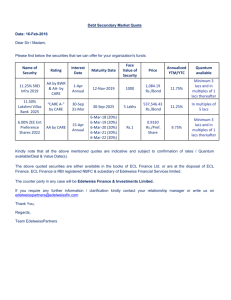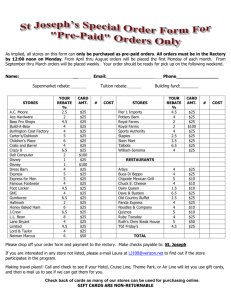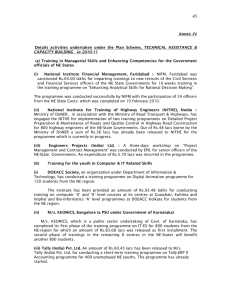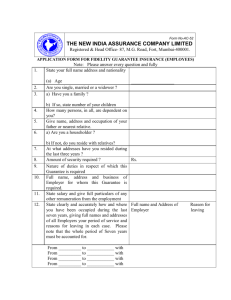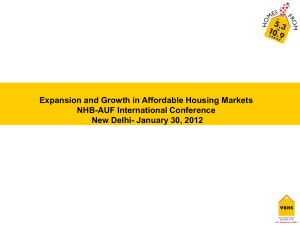14.01.2011
advertisement
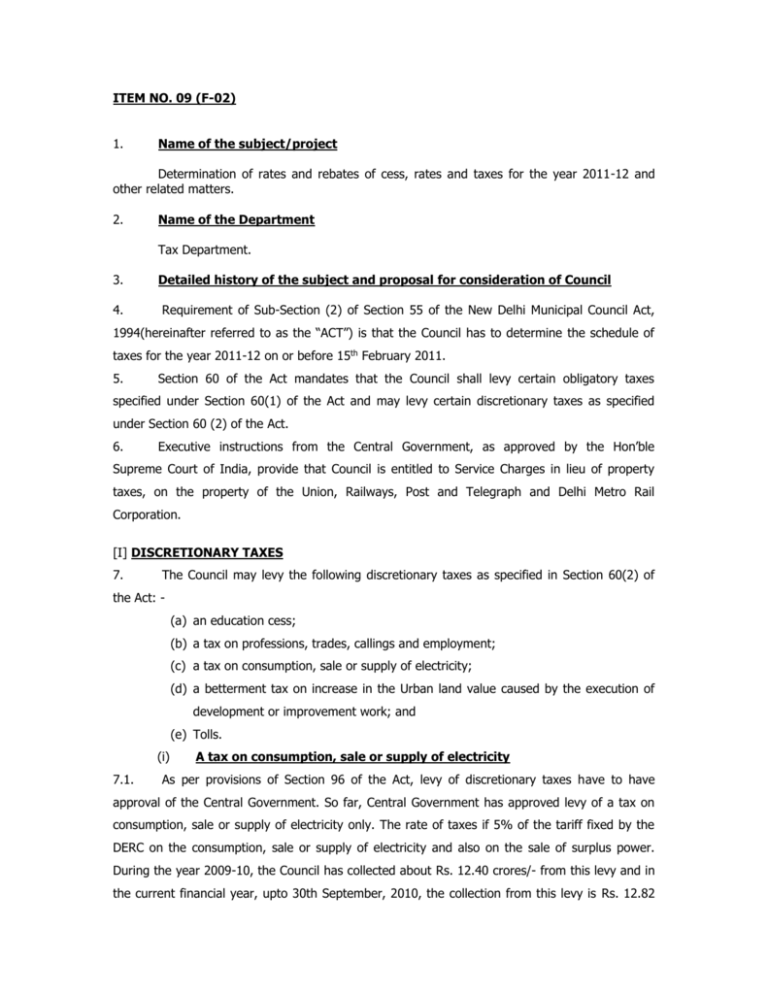
ITEM NO. 09 (F-02) 1. Name of the subject/project Determination of rates and rebates of cess, rates and taxes for the year 2011-12 and other related matters. 2. Name of the Department Tax Department. 3. 4. Detailed history of the subject and proposal for consideration of Council Requirement of Sub-Section (2) of Section 55 of the New Delhi Municipal Council Act, 1994(hereinafter referred to as the “ACT”) is that the Council has to determine the schedule of taxes for the year 2011-12 on or before 15th February 2011. 5. Section 60 of the Act mandates that the Council shall levy certain obligatory taxes specified under Section 60(1) of the Act and may levy certain discretionary taxes as specified under Section 60 (2) of the Act. 6. Executive instructions from the Central Government, as approved by the Hon’ble Supreme Court of India, provide that Council is entitled to Service Charges in lieu of property taxes, on the property of the Union, Railways, Post and Telegraph and Delhi Metro Rail Corporation. [I] DISCRETIONARY TAXES 7. The Council may levy the following discretionary taxes as specified in Section 60(2) of the Act: (a) an education cess; (b) a tax on professions, trades, callings and employment; (c) a tax on consumption, sale or supply of electricity; (d) a betterment tax on increase in the Urban land value caused by the execution of development or improvement work; and (e) Tolls. (i) 7.1. A tax on consumption, sale or supply of electricity As per provisions of Section 96 of the Act, levy of discretionary taxes have to have approval of the Central Government. So far, Central Government has approved levy of a tax on consumption, sale or supply of electricity only. The rate of taxes if 5% of the tariff fixed by the DERC on the consumption, sale or supply of electricity and also on the sale of surplus power. During the year 2009-10, the Council has collected about Rs. 12.40 crores/- from this levy and in the current financial year, upto 30th September, 2010, the collection from this levy is Rs. 12.82 crores/-. No Change in the rate of tax on the consumption, sale or supply of electricity or on sale of surplus power or the mode of collection of the same is suggested. (ii) 7.2. An education cess Council’s expenditure on providing quality education, infrastructure, computer facilities and the newly proposed ‘Lakshya’ Scheme is increasing year after year. To meet the expenditure on the same, additional funds are required and levy of an education cess can be a good source of revenue, to meet such expenditure. Council may permit that levy of education cess for providing education, other than primary education be examined and a report submitted for consideration of the Council to take a decision on the levy of this cess. (iii) 7.3. A tax on professions, trades, callings and employment A tax on professions, trades, callings and employments can be a good source of revenue. It is being levied in almost all the states. As per Article 276 of the Constitution of India, this annual tax cannot be more than Rs.2,500/- per person. At present levy of tax on professions, callings and employments is not suggested. However, levy of tax on trades only is suggested. Council may permit examining levy of this tax to meet expenditure on providing better maintenance and facilities in the markets. (iv) A betterment tax on increase in the Urban land value caused by the execution of development or improvement work 7.4. Due to development and improvement works in the NDMC area, there has been an increase in the value of the land in NDMC area. Council may permit examining levy of this tax, on the increased value of land, due to these development or improvement works. (v) 7.5. Tolls Municipal Corporation of Delhi is collecting tolls from the entry of vehicles in the NCT of Delhi. Earlier receipts from terminal tax, levied by the MCD for and on behalf of Central Government, were shared by the three local bodies namely, MCD, NDMC and Delhi Cantt. May permit this matter to be taken up with Govt. of NCT of Delhi for a share in the proceeds from this on the same principles as terminal tax. [II] OBLIGATORY TAXES 8. Section 60(1) of the Act provides that the Council shall levy the following taxes: (a) Property tax; (b) a tax on vehicles and animals; (c) a Theatre tax; (d) a tax on advertisements other than advertisements published in newspapers; (e) a duty on transfer of property; and (f) a tax on buildings payable alongwith the applications for sanction of the building plan. (i) 8.1. A tax on vehicles and animals and a theatre Tax This is a regulatory tax and is not a good source of revenue. As it was an obligatory tax, the Council decided to levy it at “NIL” rates. The same may continue for 2011-12 as well. (ii) A tax on advertisements 8.2. The rate of the taxes is provided in the Fourth Schedule of the Act. It is a nominal tax and levied per square feet on the size of the hoarding site and not on the revenue generated from the advertisements. The maximum tax payable for a hoarding is Rs. 240/- per year. If the rates of tax are permitted to be increased and based as a percentage of the receipts from the advertisements, this can be a very good source of revenue. If the Council approves, an amendment to the Fourth Schedule shall be put up to Govt. of NCT of Delhi/Central Govt. Pending such amendment, levy of this tax at the maximum rates provided in the Fourth Schedule may continue for 2011-12. (iii) A duty on transfer of property 8.3. On the instrument specified under Section 93(2)(b) and on the instruments presented for mutation under Section 74 of the Act, a duty on transfer of property is being levied at the following rates: (a) 2% if the transferee is a woman to the extent of her share in the property; (b) 2.5% if the transferee is a person other than a woman. 8.3.1.A proposal to increase the Circle rates of land and buildings, for the registration of documents, is under consideration of the Govt. of NCT of Delhi. After the proposed increase the valuation of property may go up and consequentially there would be an increase in the duty on transfer of property. As such, no change in the rates of the duty is proposed for the year 2011-12. (iv) A tax on buildings payable alongwith the applications for sanction of the building plan 8.4. The rate of tax has been provided in the Fifth Schedule of the Act. These rate were fixed prior to 1957 and there has been no increase thereafter. The tax is nominal. For a ground floor with an area of more than 1000 sq.yrds., tax is only Rs. 600/- for the First storey and Rs. 1,500/for the subsequent storey. The tax has no correlation with the price of the land or the cost of construction of the building and doesn’t cover even the cost of establishment engaged in sanction of these plans. Since the cost of construction of the building is being provided by the builder, alongwith the building plan, for the purposes of payment of Cess collected by the Labour Department of the Govt. of NCT of Delhi, the tax on buildings payable with the application for sanction of the building plan, should be a percentage of the said cost of construction of the building. If the proposal meets approval of the Council, the Govt. of NCT of Delhi/Central Govt. would be requested for amendment of the Fifth Schedule of the Act. Pending amendment in the Schedule, tax may be levied at the maximum rates provided in the Fifth Schedule. (v) Property Tax 8.5. Property tax is the most important levy for the NDMC area. It is being levied as a percentage of the rateable value of all land and buildings in the NDMC area. The properties of the Union, constructed on or after 26th January 1950 are exempt from payment of this tax, however, the NDMC is being compensated for this exemption in the form of Service Charges, through executive instructions of the Central Govt., as approved by the Hon’ble Supreme Court of India. 8.6. Upto the year 2008-09, determination of rateable value was covered by the House-Tax Byelaws of 1962, framed under the Punjab Municipal Act, 1911. With effect from 1 st April 2009, and to bring uniformity in the valuation of properties, the rateable values are being determined under the Annual Rent Bye-laws of 2009. These bye-laws of 2009 were impugned before the Hon’ble High Court of Delhi by Welfare Associations and individuals also. The Hon’ble High Court of Delhi admitted the writ petitions for hearing, as per their turn, but declined stay and directed the tax-payers to make the payment, as per the Bye-laws of 2009, pending decision in the writ petitions. RATE OF PROPERTY TAXES 8.7. The rate of property taxes for the year 2010-11 are as under: (i) On first Rs. 10 lacs of the rateable value 20% of the rateable value (ii) Where the rateable value exceeds Rs. 10 lacs and is upto Rs. 20 lacs Rs. 2,00,000/- plus 25% of the amount by which rateable value exceeds 10 lacs (iii) Where the rateable value exceeds Rs. 20 lacs Rs. 4,50,000/- plus 30% of the amount by which rateable value exceeds Rs. 20 lacs No change in the rate property tax for the year 2011-12 is proposed. COLLECTION OF PROPERTY TAXES, SERVICE CHARGES AND A DUTY ON TRANSFER OF PROPERTY 8.8. Collection of property taxes, service charges and duty on transfer of property from the year 2003-04 till 31st December 2010 is as under: Figure (in crores) YEAR PROPERTY TAX SERVICE CHARGES TRANSFER DUTY TOTAL 2003-04 2004-05 2005-06 2006-07 2007-08 2008-09 2009-10 1.04.2010 – 31.12.2010 111.74 130.31 132.87 139.44 179.92 190.63 263.56* 184.42 16.14 17.28 14.23 13.82 15.55 20.14 12.13 06.55 7.94 13.27 13.15 25.90 13.69 37.81 20.01 19.32 135.82 160.86 160.25 179.16 202.16 248.58 295.07 210.29 * This include collection from one time settlement scheme as was approved by the Council REBATES 8.9. Instead of changing rate of property tax, on implementation of the bye- laws of 2009 st from 1 April 2009, the Council decided that all those who opt for the annual rent bye-laws 2009 shall be entitled to attractive rebates at the time of payment of property taxes, on rateable values determined under Annual Rent Bye-Laws, 2009. 8.10. The purpose of formulating the bye-laws of 2009, was to remove disparities in the rateable values of the land and buildings. While removing the disparities, the buildings which were constructed on or after 1st April 1990 have been greatly benefited and the tax-liabilities substantially reduced. In respect of rented residential properties, let after 1st April 2000, mainly in the posh NDMC colonies, like Malcha Marg, Aurangzeb Road, Prithviraj Road, Panscheel Marg, Golf Links and Jor Bagh, there has been substantial reduction in the rateable values. In DhawanDeep Building, for a flat which was on a rent of Rs. 1,00,000/- per month, the tax liability was, Rs. 2,20,000/- in pre-2009 Bye-Laws. It got reduced to Rs. 1,03,000/- in New Bye-laws. A reduction by 53%. This is the general reduction in the tax-liability in this building and to this extent all the owners of the property have been benefited. In the case of Tata buildings, Upasna and other similar multi-storey buildings on Aurangzeb Raod, Prithviraj Road or Hailey Road, there has been a reduction in the tax-liability from 25 to 76% depending upon the year of construction of the building. In Malcha Marg, in a rented residential properties on rent of Rs. 8,00,000/- per month, there has been a reduction in the tax-liability by 81%. Similar is the position in Amrita Shergill Marg. Almost all the properties, constructed or purchased or rented after 1 st April 2000 there has been heavy reduction in the tax-liability. In a residential building, the tax-liability has reduced from Rs.1.32 Crores to Rs.26 Lacs. In the case of property of Power Gird Corporation at Fire Brigade lane, the tax-liability has reduced from Rs. 3.54 crores to Rs.1.36 crores per year a reduction by 61%. There have been an increase in the rateable values of other residential properties, commercial properties and hotels which were mainly constructed in pre-1990. 8.11. There has been an increase in the rateable value of RBI Building, SBI building and the building of Punjab National Bank which are self-occupied. In the building of Food Corporation of India, the tax-liability has increased from about Rs.13 lacs to about Rs.1.49 Crores and the same has been paid. 8.12. Properties with the rateable value upto Rs.1,000, if used for residential purposes were exempt from payment of property taxes . There were 1383 such properties which were exempt from payment of property taxes. In the case of Khan Market and Sarojini Market, the original cost of the shop/flat was about Rs.6,600/- and the rateable value was about 660. Tax payable was Rs.120 per year. If it was a flat used for residential purposes, it was exempt from payment of taxes. This rateable value and tax thereon had no correlation with the rented properties or flats. In the new bye-laws, when the value is being upgraded to the year 2000, there is an increase in rateable values and tax thereon. Similar is the position of Shanker Market where the shops were alloted in pre-1960s. In Bengali Market, Babar Road, Todarmal Road and similar other colonies constructed prior to 1960, the rateable values were either nominal or the properties were exempt from payment of taxes, as the rateable values were below Rs.1000. There is an increase in the rateable value of these properties. 8.13. The property profile of the NDMC area is as under: RATEABLE VALUE ANALYSIS R.V. RANGE No. of Cases Total ARV Tax Upto 1 lacs 6243 150884813 30176963 >1 lacs and<= 2 lacs 1232 177435811 35487162 >2 lacs and<= 3 lacs 1032 258551150 51710230 >3 lacs and<= 4 lacs 822 284101775 56820355 >4 lacs and<= 5 lacs 627 280584520 56116904 >5 lacs and<=10 lacs 1535 1098501502 219700300 >10 lacs and<= 20 lacs 818 1109416316 277354079 >20 lacs and<= 50 lacs 201 1211683611 363505083 >50 lacs and<= 1 Crore 125 856930150 257079045 > 1 Crore 119 4613622956 1384085887 12954 10041712604 2732037008 Total The above table shows that 48% of the properties have a rateable value of less than 1 lac and contribute about 1.1% of the total revenue. 76.5% of the properties, upto a rateable value of Rs.5 lacs, contribute about 8.5% of the total revenue. 2% of the properties with rateable value above Rs.50 lacs contribute about 60% of the total revenue. 8.14. The profile of residential and non-residential properties upto a rateable value of Rs.5 lacs and above Rs.5 lacs is as under: RV slab RV upto Rs. 5 lacs Residential 3279 (86%) Non-Residential 6677 (73%) Total 9956 (76%) RV above 5 lacs 534 (14%) 2464 (26%) 2998 (23%) Total 3813 (29%) 9141 (71%) 12954 Revenue from residential properties is Rs.27 Crores and from non-residential properties is Rs.246 Crores. Residential properties contribute 10% and Non-residential contribute 90% to the total revenue. 8.15. The property owners have been requesting that 1. there should be more than 1 categorization of the colonies; 2. the multiplication factors for the non-residential properties and for the godowns and car parking be reduced; 8.16. 3. no tax on vacant land; 4. rebate for senior citizens, women and physically challenged; 5. Additional rebate of 50% upto the RV of 10 lacs; The Govt. of NCT of Delhi has categorized NDMC as a single category. DDA has been requesting that the rates in the NDMC should be double the rates of the A-Category of MCD. As per the L&DO rates of the lease-hold land in NDMC area, the land rates of Connaught Place, Bhagwan Das Road, Hailey Road, Hanuman Road, Baird Road, Jain Mandir Road, Jantar Mantar Road, Mandir Marg, Bhagat Singh Market, Babar Road etc. are 33% more than the rates of the other colonies in the NDMC area. As such the request of the Babar Road Association to reduce the unit rates fixed by the NDMC could not be agreed to, if the method of calculation by DDA and the L&DO are taken into consideration, the unit rate in the Babar Road, have to be much higher than other colonies of NDMC. 8.17. Since most of the residential properties in the Babar Road area, B.K. Dutt Colony and other smaller properties have a RV of less than Rs.1 lakh, to meet the request of these associations, the Council decided to give a 50% rebate to all the 48% properties, which have a RV upto Rs.1 lakh. 8.18. The Valuation Committee considered the request of owners of Non-residential properties, godowns and parking-spaces and agreed to reduce the multiplication factor from 6 to 4 thereby giving a 33% reduction in the rateable values of the Non-residential properties other than the rented properties. In the case of godowns and parking spaces, the multiplication factor was reduced from 0.5 to 0.25 thereby giving a relief of 50%. In respect of the vacant land, the Valuation Committee agreed to reduce the unit rate for unconstructed portion of land of residential self-occupied properties, from 1000 to 500, thereby giving a relief of 50% in the computation of rateable value of such land in self-occupied residential properties. 8.19. The Council agreed to give a rebate from payment of property taxes to all those who opt for determination of rateable values under the Bye-laws of 2009. A rebate of 25% was allowed from the payment of property taxes on the self-occupied residential properties owned and occupied by senior citizens, women and physically challenged, if no portion of the property is on rent or used for commercial purposes. To encourage property owners to opt for the Annual rent Bye-laws of 2009, a further rebate of 10% was given for the prompt payment of taxes, if the taxes are paid by specified dates. This rebate was 5% if payment is made, after the specified date, but before 31st December. 8.20. As regards the claim for a 50% rebate on the rateable value upto 10 lacs, this would be an additional rebate of Rs.37.10 Crores i.e. about 15% of the total revenue. This demand may not be agreed to. However, keeping in view the fact that some of the residential property owners have to pay a higher tax, under the Rateable Value Bye-laws 2009, it is for the consideration of the Council, as to whether to give this 50% rebate to 3279 residential properties, which have a rateable value upto 5 lacs. This would give the desired relief to residential properties and meet their demand. Additional rebate in the segment of Rs.1 lac – Rs.5 lacs of the residential properties, would be about Rs.5 crores, which is 20% of the total contribution from the residential properties. 8.21. The New Delhi Traders Association have claimed that due to re-development work in the Connaught Place area, there has been a decline in their sales and revenue and levy of property taxes should be waived or reduced or the Bye-laws of 2009 should not be made applicable to their properties. Property tax is levied on the rental potential of a building and not on the revenue or sales earned by the occupiers. Most of the members of this Association are tenants and not owners of the shop and are not liable to tax. However, due to re-development work, there might have been some inconvenience to their customers. Council may authorize the Chairperson to give a rebate of not more than 20% to the occupiers of the shops who are themselves paying the property taxes under the Bye-laws of 2009. This rebate shall not be available to office/commercial complexes. The rebate would be available for 2010-11 and 201112. 8.22. In the case of aided schools and colleges as well as unaided schools, there is a request for grant of rebates for the portion which is not on rent or used for commercial purposes. It is proposed that a rebate of 40% and 20% may be allowed to the aided-schools and colleges and unaided schools respectively. [III] SERVICE CHARGES 9. Properties of the Union constructed on or after 26th January 1950 are exempt from the levy of property taxes. Under orders of the Govt. of India, as approved by the Hon’ble Supreme Court, Service Charges are payable on all such properties. There has been a change in the valuation of such properties in the Bye-laws of 2009. If the service charges are paid as per these bye-laws of 2009, the rebates would be admissible on service charges at the same rates as to the private properties. [IV] COMPLETION OF PENDING ASSESSMENTS AND ARREARS OF TAXES FOR THE PERIOD UPTO 31ST MARCH 2009 10. Under the Act of 1994, there is no time limit for the completion of assessment after issue of a notice under Section 72 of the Act, for increase in RV. This provision is being misused in getting the assessment delayed, creation of demand and payment of taxes. It has been seen that during the pendency of proceedings, sometimes, the properties are sold and payment of the demand on completion of assessments is disputed by the new owners. On an estimate about 2000 such assessments are pending and unless a time-limit is imposed for finalisation of these assessments, there would be tendency to get delayed, finalisation of assessment and delay in payment of taxes. It is proposed that there should be a time-limit of 3 years for the completion of assessment, from the end of the year in which the notice has been issued. On imposition of this time-limit, all the pending section 72 notices of the Act upto the period ending 31 st March 2009, under the Bye-laws of 1962, have to be completed by 31st March 2012. 10.1. It is proposed that an incentive may be given to the property owners who get their assessments finalised, for the period ending 31st March 2009 and pay the taxes by 31st September 2011. This rebate may be 10% of the additional demand raised and collected in these pending assessments. [V] SETTLEMENT OF DISPUTES(IF ANY), DECISION IN REMAND CASES WHERE DEMAND IS OUTSTANDING ON 31ST MARCH 2009 11. Last year the Council approved a ‘One-time Settlement’ Scheme to settle disputes of the above category and more than 900 applications were received. Most of these cases were attended to and demand either reduced or collected. Rebate of 10% for the demand upto Rs.20 lacs and 5% on demand above Rs.20 lacs was allowed, if the payment was made by a specified date. Sufficient number of applications were received for grant of refund, when the payment had already been made. The scheme was only to reduce the arrears of tax and not to give refunds in the cases where taxes had already been paid. It is proposed to take up remaining cases and settle the disputes, finalize the remanded cases and allow the same rebate of 10% upto a demand of Rs.20 lacs and 5% on the demand above Rs.20 lacs. 11.1. The remanded cases have to been given the same priority as to the cases where the proposal for increase in rateable values are pending, as after the case is remanded, the taxpayers are reluctant to make payment of even admitted taxes. These assessments have to be finalised before 31st March 2012. In all those cases where the tax-payers get the assessment finalised before 30th September 2011 and pay the taxes, a rebate of 10% may be allowed on the additional demand raised and paid by this date. 11.2. It is for consideration of the Council, that when incentives are being given to the property tax-payers for getting finalised the assessments, reduction or collection of the demand outstanding as on 31st March 2009 and settlement of remand cases, some incentive scheme may also be considered for the staff engaged in attending to these cases and recovery of the outstanding dues. [VI] GRIEVANCES REDRESSAL AND SETTLEMENT OF DISPUTES COMMITTEE 12. In the year 2005, the Council had approved setting up of such a committee for settlement of disputes and redressal of grievances of the cases of the revenue earning departments. This committee continued upto 2008. It was directly working under the Chairperson and Council had approved the Chairperson to settle the disputes or get settled the disputes through this Committee. It is for consideration as to whether this committee may be revived only to consider the settlement of disputes and redressal of grievances of the property tax department. The Committee, if approved, would attend to only those cases which are referred to by the Chairperson and recommendations of the Committee shall be placed before the Chairperson for further orders. 13. Financial implication of the proposed subject This is a statutory requirement. 14. Implementation schedule with timelines for each stage including internal processing Not applicable. 15. Comments of the Finance Department The proposals is a statutory requirement. 16. Comments of the Department on comments of Finance Department ----------- NIL 17. ----------- Legal implications of the subject/project This is a legal requirement. 18. Details of previous Council Resolution, existing law or Parliament and Assembly on the subject In 2010-11, the rates were approved in Resolution No.13(F-2) dated15.01.2010. 19. Comments of the Law Department on the subject/project The proposal is as per law. 20. Comments of the Department on the comments of Law Department No comments. 21. Recommendations Council may approve the proposals as contained in Paras - 07 to 12 and permit implementation, in anticipation of confirmation of minutes of the meeting. Chairperson has seen the proposal and approved its being placed before the Council as an urgent item of business. COUNCIL’S DECISION Resolved by the Council to accord approval for the following :1. (A) Rate of Property Tax:- (i) (ii) (iii) Lands and buildings or part thereof Where the rateable value does not exceeds Rs.10 lacs Where the rateable value exceeds Rs.10 lacs but does not exceeds Rs.10 lacs Where the rateable value exceeds Rs.20 lacs Rate of Tax 20% of the rateable value Rs.2,00,000/- plus 25% of the amount by which the rateable value exceeds Rs.10 lacs. Rs.4,50,000/- plus 30% of the amount by which the rateable value exceeds Rs.20 lacs. (B) Rate of Tax on vehicles and animals :- As per Schedule-II of the Act at ‘NIL’ (C) Rate of theatre tax :- As per Schedule-II of the Act at ‘NIL’ rate. (D) Rate of tax on advertisements other than advertisements published in the Newspapers:- As per Schedule-IV of the Act at maximum rate. rate. (E) Rate of duty on transfer of property :- Duty on transfer of property on the instruments specified in Sec.93(2)(b) and on instruments presented for mutation under sec.74, at the following rates :(a) 2% in case the transferee is women to the extent of her share in the property. (b) 2.5% in case the transferees are persons other than women. (F) Tax on building payable alongwith the application for sanction of the building plan :- As per Schedule-V of the Act. (G) Tax on sale or supply of Electricity :- Electricity tax is a discretionary tax under section-60(2)(c). The tax may be @5% of tariff fixed by DERC for consumption, sale or supply of electricity or on sale of surplus electricity. 2. Rebates from payment of property tax :- Rebate from payment of property tax assessed on the rateable values determined under Annual Rent Bye-laws of 2009, for the year 2011-12 may be allowed as under :(i) a rebate of 50% of the tax calculated on the rateable value upto Rs.5 lacs of lands and buildings used or to be used and occupied or to be occupied for residential purposes; (ii) a self occupancy rebate of 25% of the property tax payable after allowing the rebate at (i) above, in respect of self occupied residential properties singly owned by a sr. citizen who is sixties years or more in age as on 01.04.2011 or by a women or a physically challenged person, irrespective or their age or jointly owned by any of these categories; Provided that no portion of the building owned by such a sr. citizen or women or physically challenged person is on rent or is used for commercial purposes and the building is actually owned and occupied by these categories; (iii) a rebate of 50% of the tax determined on rateable values upto Rs.1 lac, for properties other than residential properties; (iv) a rebate of 40% of the tax payable in respect of aided schools and colleges and 20% of tax payable by unaided schools for the lands and buildings owned by Society or Body after deducting the rebate at (iii) above; Provided that no such rebate shall be available on the portions on rent or used for commercial purposes; (v) the Chairperson is authorized to give rebate of not more than 20% of the tax payable by owner or tenant, for the shops occupied by him in Blocks A – H, K – N in Connaught Place as may be decided by Chairperson; Provided that this rebate shall not be available to premises occupied by Banks or for office and commercial purposes or multiplex; (vi) on the net tax payable, after rebate as above from (i) to (v), a prompt payment of rebate of 10% of the net tax may be allowed, if the tax is paid, alongwith a return U/s-77 of the NDMC Act by 30th September, 2011 and 5% if the tax is paid after 30 st September, 2011 but on or before 31st December, 2011; 3. Resolved further by the Council to accord approval of Para-9, 10, 11 & 12 of the proposal. 4. Resolved further that date for payment of tax with rebate, if considered necessary may be extended by the Chairperson from time to time. 5. Resolved further that in case of any disputes on the question of quantum of the rebate permissible under Clause-(i) to (vi) of Para-2 or Para-3 above, the decision of the Chairperson shall be final. 6. Resolved further that rebate at Para-2(v) above would be available for the year 2010-11 as well. 7. Resolved further that proposals contained in paragraphs-7.2 & 7.3 relating to an ‘education cess’ and tax on ‘trades’ was not approved and Paras-7.4, 8.2 & 8.4 be examined and report submitted to the Council and in respect of Para-7.5, the matter may be taken up with the Government of NCT of Delhi. It was further resolved that the department may initiate action in anticipation of the confirmation of the minutes by the Council.
